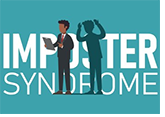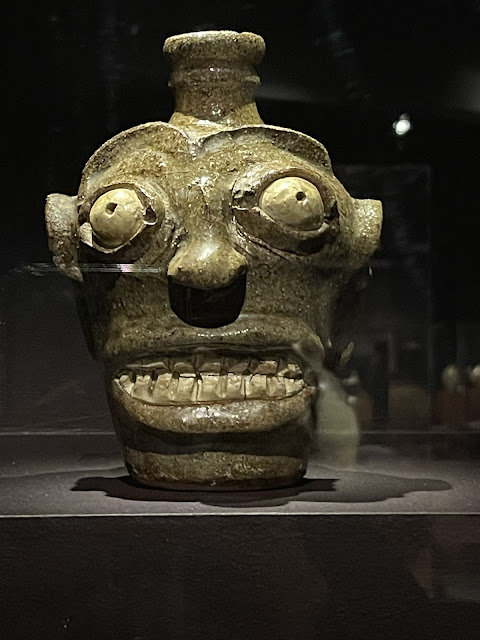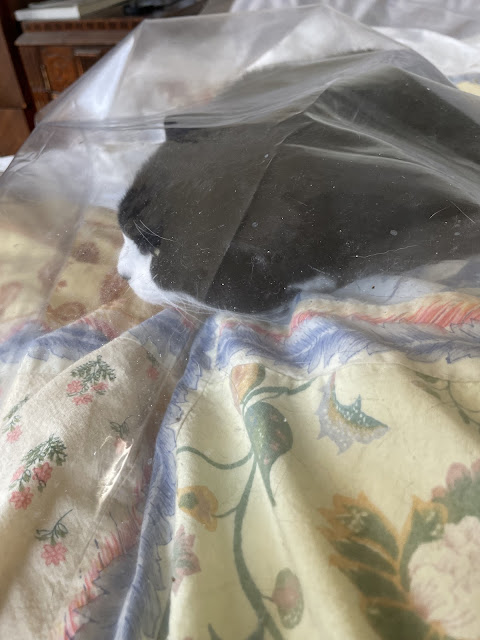Day 227, October 29, 2020
Underwood No. 11
Tonight's soundtrack: Santana at Tanglewood, 1970
I've been waking up in the early hours again, around 4 am. I'm not sure what rouses me out of my slumber, but I lie there trying to get myself comfortable, and then decide I might as well go to the bathroom, and sometimes, like this morning, I step in a puddle of cat vomit, then alternately relieve myself and try to quench a deep thirst, and alternate that with looking at the news.
I think there is a connection between the lack of a good night's sleep and shorter life expectancy, obesity, and all kinds of ills. Clearly, I do make less healthy choices like eating a breakfast sandwich and an apple plum tart before noon. And, by the end of the day, I am weary and ready for the ride home.
 Today, was an office day. I've been in the process of cleaning out my office, deciding what books to keep, and today, I parked at the bottom of the outside staircase and moved my Underwood typewriter out to the car. Back when I was completing my MFA, I lost an entire draft of my thesis when the hard drive on my Mac laptop (the one with a trackball) died. For a year afterwards, I worked on an old Underwood typewriter I found at a flea market. There was something ultimately comforting about the physical transformation of fingers activating a series of levers that threw a letter onto the platen. It was a rhythmic, athletic form of writing. When the ideas were flowing, it was a raucous clamor.
Today, was an office day. I've been in the process of cleaning out my office, deciding what books to keep, and today, I parked at the bottom of the outside staircase and moved my Underwood typewriter out to the car. Back when I was completing my MFA, I lost an entire draft of my thesis when the hard drive on my Mac laptop (the one with a trackball) died. For a year afterwards, I worked on an old Underwood typewriter I found at a flea market. There was something ultimately comforting about the physical transformation of fingers activating a series of levers that threw a letter onto the platen. It was a rhythmic, athletic form of writing. When the ideas were flowing, it was a raucous clamor.
Ultimately, I did have to return to the computer for the thesis, but for years after, I still wrote poetry and letters on the typewriter. And after I got my job at Greenfield Community College, I moved my typewriter into my office and between advising appointments, or classes, or search committee meetings, I would hammer out a few lines. All my neighbors in that particular office alcove became accustomed to the sound of the Underwood and would chuckle at the novelty. At the time it wasn't such a distant memory, the sound of the IBM Selectric, in fact, I swear the first few years the division office still had a Selectric for those few times when you needed to fill out a form in triplicate, or something like that.
But, as the years wore on, I wrote fewer letters and, as I took on more roles at the college, I had less time to work on poems between meetings. The Underwood remained a fixture in my office, but it became the thing my kids played with when they visited me at work, home sick from school, or something like that. I have a small collection of cryptic messages typed on post-it notes. More recently, the ribbon has all but dried out, and for the last handful of years the Underwood has sat banished to the periphery of my office tucked under a cloth placemat serving as a dustcover.
Lifting the old Underwood 11 and carrying it out to the car, it had a wonderfully satisfying heft, wonderfully familiar. It is a beautiful utilitarian tool from the 1930s, a marvelous combination a engineering, design, and sculpture. For a time, after I started using a typewriter, people would hear me working, or see drafts of poems splayed on a coffee table, or hear someone talking to me about typewriters, and they would say, "You know, I have my father's old typewriter in the attic..." or "My old college typewriter is sitting in the back of my closet..." and before I knew it, my typewriter multiplied and I started to amass a collection of typewriters, including a couple of dainty Smith Coronas, a Remington, and two of the old lift-top typewriter desks. I was always partial to the Underwoods, particularly the older ones with the open carriage. I had one particularly nice one with beautiful hand painted filigree work. But typewriters, and particularly typewriter desks, are heavy things to move, and in the years since I first started sniffing ink, I have let go of many of the venerable machines. I remember one, a later model Underwood with a long carriage and hammertone finish, was picked up by an artist who planned to disassemble it for a project. I almost didn't let that one go.
Hmm, now that I am remembering, I think shortly after I was hired at GCC, a local paper did a story on me and published a photograph of the subject balancing two manual typewriters, one in each hand. I imagine I was stronger back then. Or maybe I'm remembering incorrectly... but somewhere in the microfiche there must be a record of that.
In any case, the office Underwood is back home again. I'll have to research if there's a way to revive the ribbon, or seek out a new one. Surely, in this era of finding anything on the internet, there must be a place to buy typewriter ribbons. I look forward to hearing that percussive rhythm in my life again.
Take care and be well,
Leo
From Our Friends:
From Higher Ed Jobs:
by Justin Zackal
 According to a leading expert about impostor syndrome, the higher up you climb in your career, the more susceptible you are to this condition, so higher education professionals are likely to think of themselves as impostors at some point in their careers. Impostor syndrome decreases your confidence, ultimately holding you back from doing your best work and advancing your career. So how do you get rid of it?
According to a leading expert about impostor syndrome, the higher up you climb in your career, the more susceptible you are to this condition, so higher education professionals are likely to think of themselves as impostors at some point in their careers. Impostor syndrome decreases your confidence, ultimately holding you back from doing your best work and advancing your career. So how do you get rid of it?From the Poetry Center at Smith College:
A Reading by Carmen Giménez Smith
Tuesday, November 17 at 7:30 PMThe timely, searing poems of Carmen Giménez Smith insist on confronting America’s xenophobia and systemic racism. Describing Giménez Smith’s most recent collection, Be Recorder (Graywolf, 2019), the National Book Awards committee praised the ways in which her poetry “turns the increasingly pressing urge to cry out into a dream of rebellion—against compromise, against inertia, against self-delusion, and against the ways the media dream up our complacency in an America that depends on it.” Giménez Smith is the author of five additional collections of poetry, including Milk and Filth, which was a finalist for the 2013 National Book Critics Circle Award for Poetry, and celebrated by Publishers Weekly for the way that its images “challenge classist, consumerist, and socially polite forms of feminism." Giménez Smith teaches English at Virginia Tech. She also co-directs CantoMundo, serves as publisher of Noemi Press, and is poetry editor (alongside Stephanie Burt) for The Nation.
Registration Link:
https://smith.zoom.us/webinar/register/WN_SJhQwvUvTQaHi1fDbhcQlQ
From the It Gets Better Project:
It Gets Better with Singer Sarah Barrios
Bisexual singer/songwriter Sarah Barrios talks about mental health -
“It’s less of a weakness to be vulnerable and more of a strength.” Watch the video now!
From Academic Impressions:
Working Students Look to Community Colleges for Balance
Article | University Business
New report shows the strains on students who are tying to stay on top of studies while holding down jobs. Read more.
From ACE Engage:
Status Update: Race and Ethnicity in Higher Education |
New data will be presented in a soon-to-be-released 2020 supplement to ACE's Race and Ethnicity in Higher Education: A Status Report. Panelists will examine key findings during a November 10 virtual event. The latest analysis delves deeper into pre-college experiences, graduate and professional education, student loan debt, and postsecondary faculty and staff. Register now for this free webinar. |
Today's Online Teaching Tips:
From Campus Technology:
View the Distance Learning Summit On-Demand! |
As colleges and universities navigate the ever-shifting challenges of higher education's "new normal," they are also looking ahead: How can the lessons learned from the pandemic redefine teaching and learning moving forward? And how can the technology decisions made today impact the future? In these thoughtful hour-long editorial sessions, education and IT leaders share their ideas, experiences and outlook. Topics covered included:
These sessions are now available on-demand! You can access them below. | ||
| ACCESS HERE |
From Academic Impressions:
|





Comments
Post a Comment